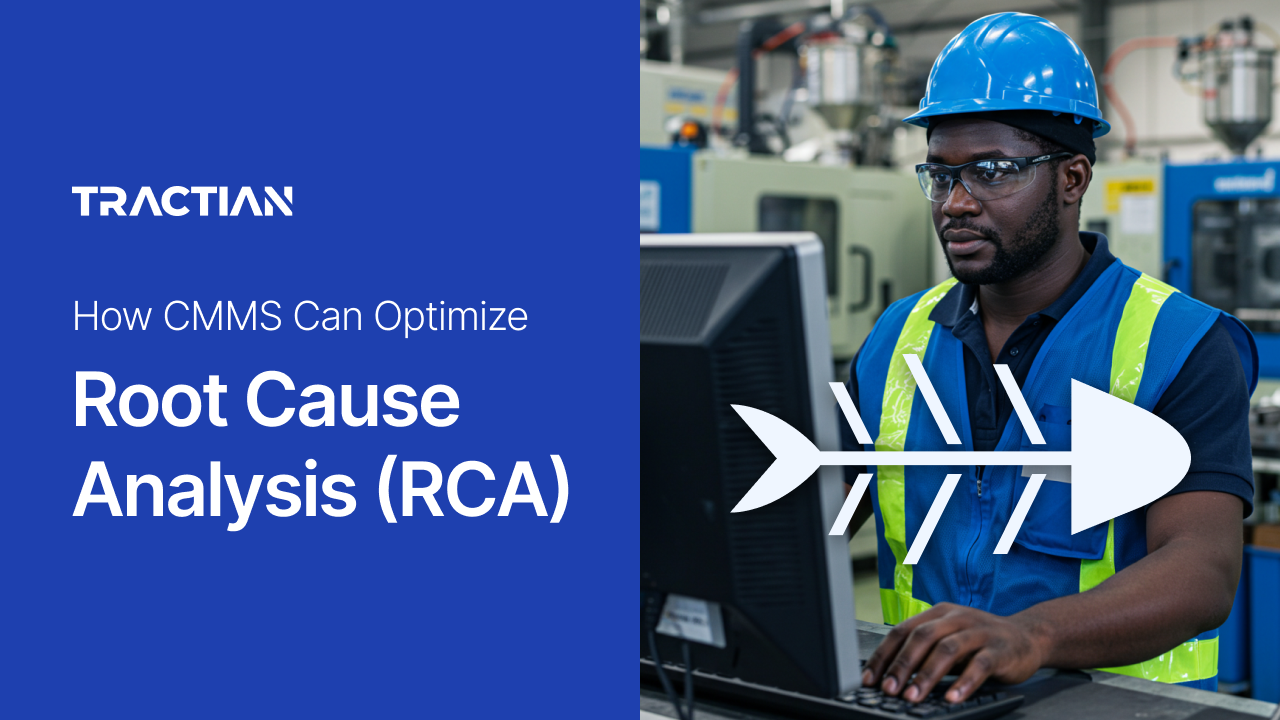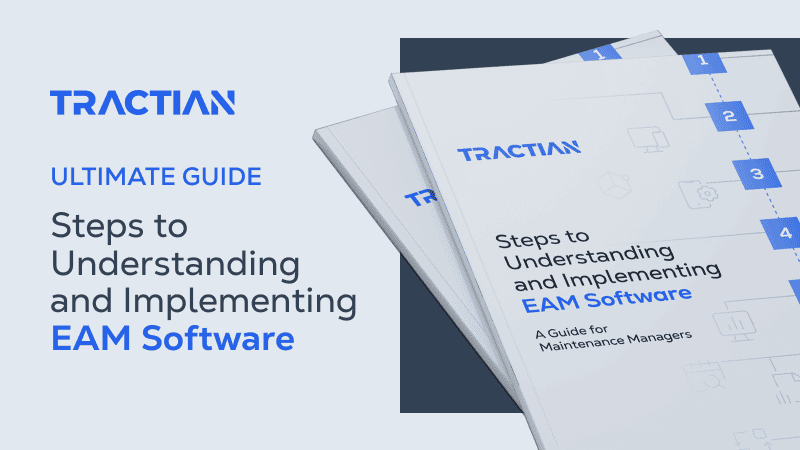When a critical asset fails unexpectedly, fixing it is usually the easiest part of getting it back into operation. The real challenge lies in figuring out why it failed in the first place and how to prevent it from happening again.
This process of discovery and prevention is why maintenance teams heavily rely on root cause analysis (RCA). It's an effective tool that uncovers what’s actually happening, rather than relying on guesswork or memory.
However, using RCA successfully depends on accurate, accessible, and well-organized data. And honestly, this is where many teams fall short. Not because they lack the knowledge, but because they lack the structure.
A CMMS (Computerized Maintenance Management System) dramatically changes that situation, bringing structure, clarity, and visibility where teams need it most.
When fully integrated into daily operations, CMMS software becomes a new working foundation for technical investigation. It captures failure data the moment it occurs, tracks patterns across time and assets, and keeps every piece of operational history readily accessible.
This article breaks down how a CMMS can strengthen your maintenance teams’ root cause analysis efforts, helping build a smarter, more resilient approach to reliability throughout the company. Reliable assets need reliable systems. Reliable systems need reliable data.
What is a Root Cause Analysis?
Root Cause Analysis (RCA) is a systematic process used to determine the root cause of a failure. It focuses on understanding what happened, why it happened, and how to stop it from happening again.
It looks beyond symptoms to isolate the real issue behind equipment breakdowns, whether that’s a faulty component, human error, or a process gap.
RCA in industrial maintenance helps teams avoid repeat failures by exposing the underlying triggers that often go unnoticed. It brings logic into the troubleshooting process., It replaces hunches with evidence and reactive fixes with long-term solutions.
How Does RCA Work?
RCA begins with a clear definition of the problem. What exactly went wrong? Was it a complete shutdown, performance drop, or erratic behavior? The problem statement must be specific and rooted in observable data.
If you can’t pinpoint and observe a location on a map, you can’t determine a path. The precise issue is your starting point.
Once the issue is defined, teams collect all the relevant evidence. This includes sensor readings, work order history, operator notes, and any maintenance performed prior to the failure. The goal here is to understand the conditions around the event.
With a determined location and knowledge of the terrain, you can successfully move along the mapped solution path.
From there, a timeline is developed. Teams reconstruct the sequence of events leading up to the failure to separate symptoms from causes.
Next comes the analysis.
Depending on the situation, teams may use tools such as the 5 Whys, Fishbone Diagrams, or Failure Mode and Effects Analysis (FMEA). These methods guide the investigation and help pinpoint the exact fault or chain of events that led to the breakdown.
Finally, the process ends with a corrective action.
This demonstrates why fixing the issue is the easiest part. It’s the last thing you do. But, understanding what happened and ensuring it doesn’t happen again requires adjusting processes, updating inspection routines, or redesigning components if necessary.
What is the Role of CMMS in Root Cause Analysis?
It’s about reliability. It’s that simple.
Root cause analysis only works when it’s fed with precise, structured, and timely data. How do you get precise, structured, and timely data? That’s the role a CMMS fills.
A Computerized Maintenance Management System (CMMS) transforms raw operational inputs, such as failure reports, work orders, and inspection logs, into an organized system of records.
When integrated into daily workflows, it becomes the engine behind any technical investigation. With a CMMS, your team gains visibility into every detail leading up to the incident, enabling them to trace problems with greater precision and speed.
To understand this better, let’s break down the core functions that make this possible:

1. Data Collection and Storage
One of the biggest barriers to effective RCA is the presence of fragmented or incomplete data. A CMMS eliminates this by centralizing and maintaining all maintenance-related events.
Every action-whether it’s a reactive intervention, scheduled inspection, or calibration task-gets logged. These entries are timestamped, asset-linked, and stored in a consistent format, creating a reliable baseline for any investigation.
This centralized approach eliminates guesswork from analysis, ensuring that data is readily available when needed and accurately reflects what actually occurred, rather than what someone recalls happening.
2. Maintenance History Tracking
When working with asset failures, you need the full context: what was done, who did it, how long it took, what parts were used, and what symptoms were observed.
CMMS platforms make this accessible with just a few clicks, providing access to the entire lifecycle of an asset. This includes: complete maintenance frequency, types of interventions, and past anomalies.
This level of traceability is critical when searching for patterns. Was this the third time a gearbox overheated after a scheduled shutdown? Has this pump consistently failed after lubrication tasks?
Those patterns don’t emerge in spreadsheets, but they’re uncovered through consistent historical tracking, and that can be facilitated by a CMMS.
3. Failure Analysis
In addition to supplying data, the CMMS gives structure to the investigation when it comes time to conduct the actual analysis.
Teams can tag failure modes, track recurring failure codes, and categorize issues based on component, location, or cause. Over time, this builds a powerful database that reveals systemic weaknesses, whether it’s recurring human error, incompatible spare parts, or skipped inspections.
And because failure tags are part of a closed-loop system, the analysis doesn’t end at diagnosis. It also informs how tasks are planned going forward, ensuring that every finding drives action.
4. Work Order Tracking
A proper root cause analysis depends on context. And that context often lives in your work orders. When technicians record failure symptoms, repair steps, and replaced parts, they’re building a trail of evidence. This information is scattered across emails, spreadsheets, or paper forms without a CMMS.
With digital work orders, everything is captured in real time. You can search for specific failure codes, filter by asset or technician, and isolate similar interventions across time. That visibility accelerates investigations and maintains the focus on facts, rather than assumptions.
It also reduces noise. Instead of combing through vague reports, you get standardized entries with predefined fields: asset ID, fault type, time-to-fix, and cause codes. That level of detail accelerates RCA and supports better decision-making.
5. Equipment Reliability Metrics
RCA isn’t complete without performance data. You need to know how often a machine fails, how long it stays offline, and what those failures are costing the operation. That’s why CMMS tools track key reliability indicators, such as Mean Time Between Failures (MTBF), Mean Time to Repair (MTTR), and total downtime hours.
These metrics give context to every RCA. If an asset’s MTBF is trending downward, there’s a clear signal to dig deeper. If MTTR is increasing, it might indicate that past RCAs haven’t effectively addressed the core issue.
A CMMS also helps quantify the impact of failures. Understanding the impact enables teams to assess the extent to which any given failure disrupted performance.
6. Prioritizing Maintenance Activities
RCA insights only matter if they influence what happens next. A CMMS connects those insights to planning, helping teams reallocate time, resources, and attention based on actual risk instead of routine.
Let’s say a recurring fault is traced back to a flawed installation process. Instead of just updating one asset’s settings, a CMMS can help roll out a new inspection checklist across every similar asset class.
At the end of the day, when priorities are driven by RCA findings, teams typically transition from reactive maintenance to a more strategic approach. The CMMS ensures those priorities are reflected in the maintenance calendar, assigned to the right people, and tracked to completion.
How to Use CMMS for Root Cause Analysis
Root cause analysis doesn’t need to be an isolated initiative. It actually works best when it’s built into the tools your team already uses every day. A well-configured CMMS creates that foundation, giving structure to each stage of the RCA process.
Here’s how to put CMMS-backed RCA into action:
Determine the Event with the Incident Tracking Feature
The first step in any RCA is to isolate the event. What happened, when, and where? A CMMS with incident tracking enables teams to log failures or anomalies the moment they occur.
These entries are tied directly to the asset, time-stamped, and automatically linked to other data, such as technician notes or triggered alerts. This gives you a clean, objective starting point for analysis and eliminates the lag between the incident and the investigation.
Team Set-Up with Team Management
RCA isn’t a solo process. It requires cross-functional insight, from technicians to reliability engineers. CMMS platforms with built-in team management features let you assign tasks, define roles, and centralize communication.
Rather than relying on side emails or hallway conversations, every participant gets access to the same incident data, action logs, and status updates. This coordination helps prevent miscommunication and maintains clear accountability throughout the analysis.
Event Description with Fault Reporting
Once the team is assembled, the next step is to detail what happened. Fault reporting tools within a CMMS enable technicians to describe symptoms, behavior prior to failure, and initial corrective attempts-all linked to the asset and timestamped incident.
This description builds context. It also helps differentiate between similar failures and filters out false positives or irrelevant alerts. Over time, the system builds a database of fault scenarios that can expedite future RCA cycles.
Contributing Factors with Equipment Performance Measures
After defining the failure event and capturing the fault report, it’s time to explore what might have led to the problem. This is where equipment performance data becomes essential.
Within a CMMS, you can access historical metrics, including temperature trends, vibration levels, runtime logs, and other condition-based indicators.
Instead of relying on theories, teams can validate whether the asset was operating under excessive load, outside of normal parameters, or exhibiting early signs of wear. These performance measures help uncover hidden contributors and eliminate assumptions that don’t align with the actual data.
Corrective Action with Work Order Management
Once the root cause is identified, the next step is to implement the fix and ensure it’s properly documented. With CMMS work order management, you can assign the corrective action to the right technician, schedule the task, and attach all supporting data directly to the work order.
Every step of the resolution is logged, from parts used to time spent on the task. This ensures traceability and helps validate whether the corrective action effectively addressed the root cause.
Evaluation and Monitoring with Reports
RCA doesn’t stop after implementation. Ongoing evaluation is necessary to confirm that the issue won’t resurface. CMMS reporting tools allow you to track follow-up metrics, monitor recurring failures, and evaluate whether asset performance has stabilized.
You can also build custom reports to monitor similar assets, spot trends, or identify other areas at risk for the same issue. This closes the loop and reinforces a data-supported continuous improvement cycle.
Why is Tractian’s CMMS Different?
Root cause analysis only delivers results when supported by a structured, data-backed system.
A CMMS enables that structure. But not every software is built to turn data into decisions. Most CMMS solutions stop once the failures are logged.
Tractian takes it a step further by connecting those failures to asset behavior, work order execution, and real-time performance indicators, all in one place, giving you full visibility of your assets and their history.
Every symptom, action, and insight is centralized and contextualized, making it easier to understand what went wrong and what changes are needed.
Because RCA is a continuous reliability effort, Tractian’s CMMS evolves with your process. It adapts to your assets, learns from repeated issues, and supports ongoing improvement through built-in analytics, fault tracking, and collaborative workflows.
Tractian's implementation process is quick and free of charge. Your factory can start collecting results from the CMMS within a few weeks.



